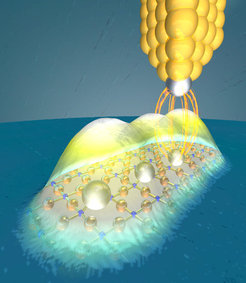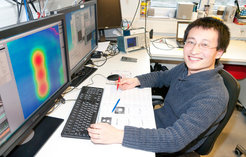Supermagnetic field in a confined space
Max Planck physicists discover an effect that can reverse the polarity of individual nanomagnets

First, the physicists created a remarkable nanostructure: They arranged three iron atoms into a short chain on a smooth copper surface using the fine tip of a scanning tunneling microscope. This created a tiny nano-magnet. Next, they picked up more iron with their microscope - with the effect that some iron atoms adhered to the tip and thereby made it magnetic. The researchers then maneuvered the tip very close and with high precision over the iron chain. Since the microscope was upgraded to measure extremely fast processes the team was able to analyze what was happening in the iron chain with nanosecond speed. The surprising result: "Depending on the position of the microscope tip we could reverse the polarity of the magnetic field of the iron chain for a short time," says group leader Sebastian Loth. "We were amazed how well it worked."
The explanation: Because of a quantum effect a magnetic field with special characteristics is established between microscope tip and iron chain. "On one hand, it is extremely strong, on the other hand spatially very confined," says Shichao Yan, lead author of the study. The strength reaches a value of several Tesla, more than the best permanent magnet. At the same time, the field is limited to an area the size of an atom. "With this strong spatial confinement we can control tiniest nanostructures individually," explains Loth. "A single small group of atoms can be made to reverse its magnetization, its neighborhood, however, remains completely unaffected."

This new effect is interesting for two fields of application. It could be suitable as a control process for quantum bits - the switching unit of a novel type of computer, the quantum computer. An ordinary PC calculates with digital bits, i.e., with switching units that are either "zero" or "one". A quantum computer is based on quantum bits which accept all values in between, which will allow higher processing speeds in the future. So far, however, there are relatively primitive laboratory prototypes - which is partly because that quantum bits cannot be controlled precisely enough. "Here, the new effect could lead to progress," says Loth. "With its help, one could control individual magnetic quantum bits." The triatomic iron chain already shows some properties of a quantum bit. Now the researchers think about how to further expand these properties.
In addition, the phenomenon could be relevant for data storage. If smaller bits can be written and read they can be packed more densely and allow storage media with higher capacity. "Extremely small magnetic nanostructures can be controlled with our method," says Yan. "Theoretically it would be possible to increase the storage density by several orders of magnitude." The triatomic iron chains which the researchers have experimented with up to now would be of no use for data storage: they can be written and read efficiently but they lose their information within microseconds. Now, the researchers want to apply the new effect in nanostructures which have the ability to become stable magnetic bits.

